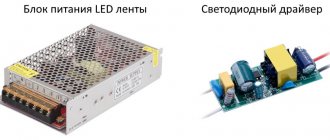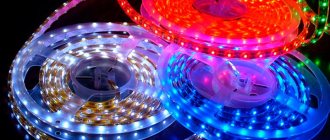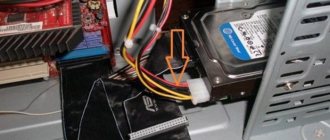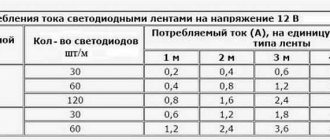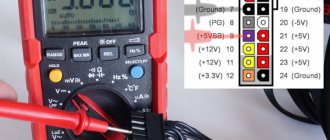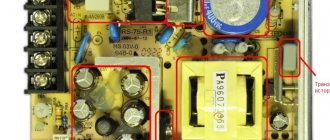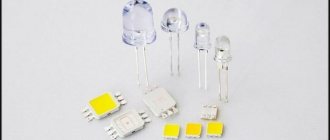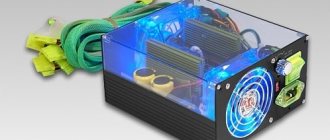The 12V power supply for the LED strip provides the need for reduced voltage when using LEDs for lighting residential premises or streets. These devices can be of any length, but their energy consumption will be minimal. The devices have increased light output and efficiency.
Operating principle of the lighting device
The LED strip connection diagram is easy to use. The device is powered by 12v power sources. To convert the mains voltage to 220V, you need a power source with a current stabilizer, that is, a driver, which is an adapter. These devices, which have differences, are characterized by different ways of functioning.
Many types of LEDs require a voltage of about 2-3 V, and LED devices are powered by 12v sources.
Single LEDs are connected in series, and the power supply circuit itself operates in the presence of a limiting resistor. It is current that is required to power the LED. When it drops in the circuit, current flows through all the elements, that is, these same 2–3 V are needed for the operation of the device.
LEDs are devices that are sensitive to the amount of current that needs to be stabilized. Otherwise, exceeding it will negatively affect the service life of the device. Having figured out what kind of power supply is needed for LED lighting, you can ensure stabilization of the voltage of the current source.
All semiconductors are characterized by an increased level of temperature dependence. Tape is the basis of electronic temperature meters. If the temperature of the external environment changes, then at the same time there is a change in the current flowing through the lighting device, provided that the input supply voltage of the LED strip is constant.
The use of stabilizers is due to the fact that LED lighting is often necessary where the range of temperature fluctuations is not too high. Another advantage of using stabilizers is the parallel connection of lighting fixtures. When the voltage drops in such a circuit, the current begins to increase. Drivers are usually used for outdoor lighting because temperature fluctuations are large.
Join the conversation
The remaining cells, indicated in green, retain their current capacity level when the charging process stops, and continue to charge when it resumes. This is the battery we assembled today and figured out how to charge it.
Some systems do not connect the load without waiting for the battery to be recharged to a certain voltage after the overdischarge trigger is triggered, that is, it is not enough to recharge the element for a couple of minutes for it to work for at least a short time - usually it is necessary to charge it to the rated voltage 3. The main advantage of self-assembling batteries from individual cells is the possibility of obtaining a prefabricated battery kit as close as possible to the user’s needs in terms of operating parameters and capacity.
I set it to print on a 3D printer from ABS and after a few hours everything was ready: When screwing everything on, I decided not to trust the screws and fused these M2 insert nuts into the body. But over a long distance, the banks that constantly receive the largest amount of energy will gradually begin to wear out.
To check, I first simulated this part of the circuit: And this is what I got from the results of its operation: On the X axis - time in milliseconds, on the Y - voltage in volts. For now, we will set the charging current to approximately 55mA, because the voltage of the cans is different and they need to be properly balanced. The red one was bought as a backup, over time it became the main one - I kept it until the last analysis - out of 10 cans, two had already died to zero at that time, but the battery was spinning! Try it and most importantly don’t rush.
Some BMS models can be adjusted for different types of batteries, their voltage levels, current values, and capacity. Balancing is a method of distributing charge evenly among all cells of a battery, thereby maximizing the life of the battery. The BMS controller is equipped with one more, in the opinion of many, the most interesting function.
What is BMS?
The green board with indicators only showed the presence of power; it never indicated the end of charging - for now I left it for that purpose, but I’m going to throw it away and plug it in. I bought an Ampere-Voltmeter, but I don’t have time to tinker! To control the charging and balancing process, a key was connected in series, the opening and closing of which was carried out according to a command received from the BMS. Full size Battery installed on the charging base and balancing connected The old black battery, when it finally ran out, was converted into an adapter with a cable and crocodile clips for connecting to a car battery - so I first calculated that if the engine could withstand the voltage of 14.2V from a running car, then must withstand 16V - anyway, these 16 will sag and it will be normal!
The load is a resistance of 1 ohm. The voltage on each of the cells combined into a lithium iron phosphate battery must be within certain limits and be equal to each other.
With a series connection, uniform distribution of charge between the cells does not occur, as a result of which some elements remain undercharged, while others are recharged. A short circuit of such a battery, even a discharged one, can lead to big troubles. Continued battery assembly (BMS connection)
Power supply power
The power of power supplies for LED lamps is determined by a similar indicator of the total load of all devices connected to the circuit. The permissible power level limit may be violated, which causes unstable operation of the device or overheating. A power source whose power level is below the maximum permissible can be connected to the tape.
The power reserve of the power supply for the LED strip is large, so its cost increases. The principle of current stabilization means that its value remains unchanged for different output voltage options. For example, according to Ohm's Law, a 12v lamp with a power of 1W consumes a current of 0.83 A.
An equal amount of current is provided by the driver, connecting to which the LED lamp at the output of the power source will be 12v. If 2 devices are connected to it, which are connected in series, then the current at the output of the circuit is 24V, if 3 lamps - 36V.
They can be connected further until the output voltage is limited, after which the current also drops.
You cannot connect several LED lamps to the driver at once, since the output current must be divided proportionally between the devices. The use of drivers is limited by the complex design of the lighting system, which excludes the possibility of changing the number of connected lighting fixtures.
Purpose of the power supply
When choosing a LED strip kit for interior decoration, you should take into account its features. The device cannot be connected directly to an outlet, like a simple light bulb, since the voltage of the strip is not 220V, and when it is plugged into a regular outlet, it will stop working.
If an incandescent lamp is powered from a 220V network, then to reduce the voltage in a standard network to 12 or 24 volts, a power supply for the LED lamp is required. There are several types of such devices.
Power supply for LED lamps. The advantage of the device is its minimal size, but the disadvantages include:
- high price;
- difficult heat exchange;
- power limitation (there are no devices for lighting 12V 100W or more).
An expensive model of the LED lamp power supply has an aluminum housing. Among the advantages of this transformer are:
- reliability;
- tightness;
- strength.
The scope of use of this device is related to outdoor illuminated advertising. Thanks to the presence of an aluminum housing, normal heat exchange is ensured. The power source is resistant to the negative effects of various factors:
- moisture;
- sudden temperature changes;
- direct sunlight.
An open type power supply is a budget option that is especially popular. Often used when installing home lighting using LED strips. The downside is the size of the device, which can be 2 times larger than previous options.
The device has an unaesthetic appearance and lacks protection from moisture and dirt.
The network compact power supply for LED lamps is a miniature device with a power of no more than 60W, the inclusion of which does not require installation. The devices are easy to use because the tapes are connected to a power supply and then plugged into an outlet.
Pulse UPS SC120W-12
UPS SC120W-12.
In home automation, there are often consumers who require uninterruptible power. At the same time, they consume relatively large power in order to power them from the BPS I proposed earlier. However, these consumers are quite capable of doing without AC mains voltage. Today we will look at something in between what we are accustomed to understand by the abbreviation UPS (Uninterruptible Power Supply) and the UPS already known to us. In this article we will talk about pulsed 120W UPS AC 220V / DC 12V (SC120W-12) with backup from a lead acid battery.
The UPS is available in several versions.
- 12V 8A built-in indication (LINK).
- 12V 8A remote indication (LINK).
- 24V 4A built-in indication (LINK).
- 24V 4A remote indication (LINK).
Why is it needed at all?
Indeed, there are a lot of standard UPSs (UPS) on the market now, why not just take and use them? It's possible, but:
- This is the price.
- A standard 220/220 UPS has fairly high conversion losses. Which greatly reduces battery life.
- Replacing adapters with stabilizers, again, only adds advantages to the SC120W-12.
- Noise, as a rule, most UPSs have on board, not the quietest, a fan on a rolling bearing. Undoubtedly, it happens that the proposed UPS also needs a fan; the Chinese, as always, are tricky with power


